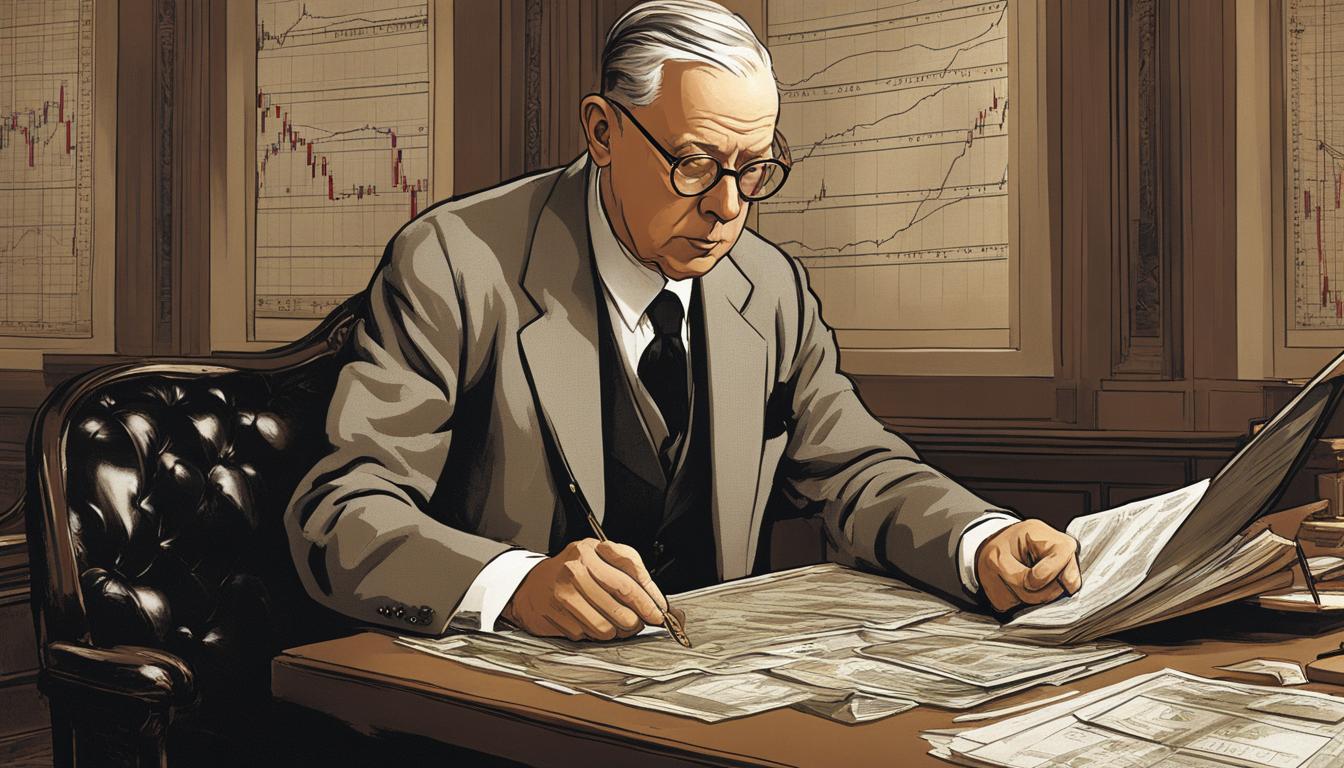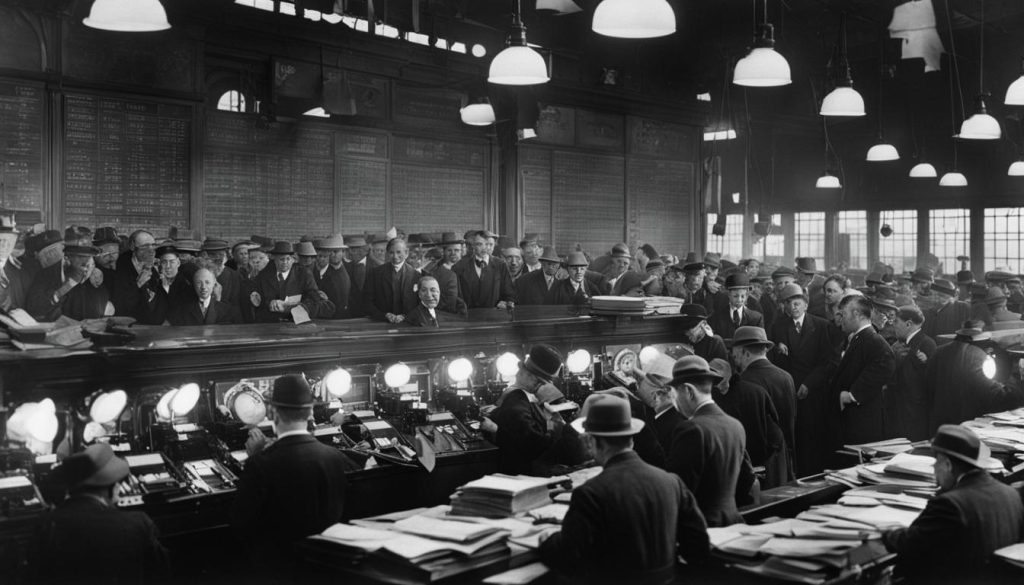The annals of financial history are rich with tales of extraordinary figures, but few have left a mark as indelible as Jesse Livermore, a paragon of stock market success. Esteemed for his astuteness in trading strategies and unmatched investing prowess, Livermore etched his name among the luminaries of Wall Street.
His story is not just a trader biography penned in dollars and cents—it’s a chronicle of a man who, from his prodigious ascent to the zenith of speculative trade to his heartrending fall, embodied the very essence of market speculation. Delve into the legacy of Jesse Livermore, a trader whose life’s work still resonates in the chambers of global finance.
The Making of a Market Maverick: Jesse Livermore’s Early Trading Journey
In the annals of financial history, few have carved out a legacy quite as remarkable as Jesse Livermore. A name synonymous with vast fortunes made and lost in the stock market, his early trading days were fundamental to developing strategies still studied by modern traders in day trading, swing trading, and overall financial market speculation. Livermore’s journey from a precocious talent in obscure bucket shops to a towering figure on Wall Street is a tapestry of tenacity, intuition, and the relentless pursuit of market mastery.
The Beginnings of a Stock Trading Prodigy
Jesse Livermore showed an uncanny ability to discern patterns in stock prices early on—a skill that became evident when he took a position at a brokerage in Boston. At just 14, he demonstrated such a keen eye for market movements that locals began referring to him as “The Boy Plunger,” a nod to his depth-ending forays into the markets that would often yield prodigious profits. This phase of Livermore’s life sowed the seeds for his immense Jesse Livermore net worth that would later become legendary.
From Bucket Shops to Wall Street: Rising to Fame
Livermore’s transition from the small-time, high-stakes world of bucket shops to the grand stage of Wall Street was marked by his adept understanding of financial markets and an unprecedented ability to predict their fluctuations. His strategic bets, particularly his audacious short selling before the crashes that punctuated the early part of the 20th century, cemented his status as a financial titan. It was during these tumultuous times that Livermore’s fortune ballooned, reflective of the enormous opportunities that can be captured by those with foresight and nerve in the financial markets.
Breaking Down the Livermore Trading Philosophy
Jesse Livermore’s approach to financial markets has captivated traders and analysts for decades. His emphasis on understanding market behavior and capitalizing on price patterns has shaped contemporary market analysis. Let’s delve into how Livermore’s wisdom remains relevant in today’s complex world of market speculation.
Understanding Market Behavior and Trends
For Livermore, the market was a pulsing entity, characterized by rhythmic trends that savvy investors could interpret and use to their advantage. He is often quoted for his astuteness in market behavior, with one of the famous Jesse Livermore quotes stating, “Markets are never wrong – opinions often are.” By studying past market trends, Livermore developed a keen eye for identifying potential moves, often going against the grain of public sentiment to execute his trades.
Livermore’s Take on Price Patterns and Market Dynamics
Livermore’s methodology involved a deep dive into the undercurrents of market dynamics where he observed price patterns that others often overlooked. His strategy was not just a matter of speculation; it was an art form that combined intuition with an almost scientific study of the market’s fluctuations. This perspective enabled him to recognize false market signals and anticipate movements before they became manifest, finding opportunity where others found confusion.
Emphasizing the importance of personal judgment over crowd psychology, Livermore’s speculations were based on concrete patterns, ensuring that even his riskiest moves had a foundation in observable market behavior. His principles continue to infuse modern market analysis with a sense of rigor and a respect for the often unpredictable nature of the financial markets.
Jesse Livermore Trader Strategies
In the landscape of financial markets, few have managed to achieve legendary status through their investing acumen and trading strategies as that of Jesse Livermore. A maven of the stock market, Livermore’s trading insights remain remarkably relevant for traders seeking to understand the intricacies of stock movements and leverage opportunities for profit.
Mastering the Art of Trade Entry and Exit
One of the key aspects of Livermore’s methodology lay in the nuanced art of determining when to enter and exit the market. This precision in timing sought to capitalize on the moments that offered maximum potential for reward. By religiously following price actions and volume patterns, Livermore was able to identify opportune moments that defined the success of his trades, establishing a precedent for modern investing strategies.
Leveraging Pivotal Points: Breakouts and Reversals
Livermore’s strategy shone brightly when it came to identifying and acting upon pivotal points in the market, such as breakouts and reversals. He believed that a disciplined approach to these critical junctures could lead to the most substantial gains. By recognizing a stock’s potential to break out of its normal range or reverse its course, savvy traders can harness the volatility harnessed within these moments—echoing Livermore’s tactical approach to trading.
Risk Management: The Keystone of Livermore’s Approach
The underpinning of Jesse Livermore’s philosophy was an unwavering commitment to risk management. Livermore’s strategies incorporated strict stop-loss orders and meticulous attention to position sizing, illustrating his understanding that preserving capital was just as crucial as identifying profitable trades. Investors today continue to integrate this tenet into their trading mechanics, associating risk management with the sustainability of their financial pursuits.
| Strategy Component | Description | Contemporary Application |
|---|---|---|
| Trade Timing | Optimal entry and exit points based on price action and trend strength. | Use of technical analysis tools such as moving averages and momentum oscillators. |
| Breakout Recognition | Acting upon stocks breaching certain price levels or moving averages. | Implementation of traders’ algorithms designed to detect early signs of a breakout. |
| Risk Control | Employing stop-loss orders to minimize potential losses. | Advanced risk management systems and software to monitor and adjust positions in real-time. |
Livermore’s Financial Triumphs and Tribulations
The story of Jesse Livermore is a riveting one, marked by a series of extraordinary financial highs and devastating lows. His proficiency in market speculation led to a legendary status on Wall Street, reflecting a narrative that resembled the volatile markets he traded. Unraveling the enigma behind Jesse Livermore’s net worth reveals the tale of a speculator who, at his zenith, held a fortune comparable to the wealthiest in the finance world.
Livermore’s strategies and market maneuvers enabled him to amass significant wealth throughout his career, yet his financial journey was anything but linear. The following table encapsulates the contrast between Livermore’s peak net worth during the height of his career and the financial strains before his passing.
| Financial Milestone | Estimated Net Worth | Adjusted for Inflation (Today’s Value) | Notes |
|---|---|---|---|
| Pre-1929 Market Crash | $100 Million | Billions | Profited from market downturns |
| Post-Crash and Subsequent Years | Varied with Market Conditions | Fluctuating | Multiple bankruptcies and recoveries |
| Time of Death (1940) | Debt-ridden | Negligible | Difficult end of life circumstances |
Livermore’s significant downturns followed patterns of aggressive trading and personal turmoil. His resilience and ability to recover from financial lows, however, were as remarkable as his knack for capitalizing on market opportunities. Even after facing bankruptcy, Livermore would repeatedly find his way back to solvency, showcasing the persistence and sharpness that made him a Wall Street icon.
- Mastered the art of short selling during market panics
- Adeptness in reading market signals and timing of trades
- Personal adversities reflecting market volatility
In the annals of trading history, the complexity of Livermore’s financial endeavors leaves a powerful message on the inherent risks and rewards in the world of market speculation. His story serves as a testament to the potential for great achievement within the financial markets, while also standing as a cautionary reminder of the capriciousness that often accompanies vast wealth derived from such volatile endeavors.
Jesse Livermore Trader: A Legacy That Endures in Financial Markets
The indelible mark left by Jesse Livermore on the financial markets is undeniable. Diving deep into his trader biography reveals a figure whose strategies and foresight laid foundational principles for technical analysis and offer valuable insights for personal investing. Livermore’s methodology, epitomized by his precision in market trend analysis, established a new paradigm in understanding the financial markets. Moreover, his forthrightness about the psychological trials faced by traders remains illuminating for professionals navigating today’s complex trading environments.
Jesse Livermore’s Influence on Technical Analysis
The tools and concepts of technical analysis so widely employed today are significantly indebted to Livermore’s contributions. His emphasis on price action and volume—and disregard for extraneous noise in the market—paved the way for a generation of traders who champion chart patterns and trends over all else. The Jesse Livermore quotes that pepper trading manuals and the annals of financial lore are testaments to the wisdom that still guides market speculation.
The Psychological Aspects of Trading: Lessons from Livermore
However, it’s not solely Livermore’s technical prowess that garners admiration, but also his candid discourse on the psychology of trading—articulating the emotional challenges and the necessity of discipline amidst the vicissitudes of fear and greed. These are the aspects that humanize his narrative beyond cold, calculated trading strategies, providing a cautionary and yet inspirational tale for anyone investing in today’s volatile financial markets. As complex as these markets may seem, the principles left behind by Jesse Livermore provide a beacon, guiding investors towards informed, strategic decision-making built upon a robust psychological foundation.
FAQ
Jesse Livermore was a renowned American trader, famous for his formidable stock market success in the early 20th century. Known for his acute analysis of market behaviors and trend-based trading strategies, he earned a place in the annals of investing history. His most notable achievements include his profitable prediction and trading of the 1907 and 1929 market crashes.
Livermore’s trading strategies revolved around trend analysis, identifying pivotal market points for trade entry and exits, and recognizing patterns including breakouts and reversals. He was also a pioneer in using stop-loss orders and emphasis on risk management to protect his positions.
Livermore began his career in the financial markets as a young boy, working at a brokerage firm in Boston where he started noticing stock price patterns. By age 15, he was trading at bucket shops and quickly gained notoriety for his ability to speculate on price movements.
Yes, Livermore’s approach was primarily technical. He focused on chart patterns and price movements to make trading decisions, and he was less concerned with the intrinsic value of the securities he traded.
During his lifetime, Jesse Livermore’s net worth fluctuated dramatically due to his speculative nature. He made and lost fortunes several times over. At his peak after the 1929 crash, he was worth an equivalent of over $100 million in today’s dollars, but he died with debts and his financial situation was considerably diminished.
Jesse Livermore is known for several quotes that encapsulate his trading philosophy. One of his most famous quotes is, “The market does not beat them. They beat themselves, because though they have brains they cannot sit tight.”
Livermore’s focus on price actions and market trends heavily influenced the field of technical analysis. His emphasis on chart patterns and the psychological aspects of trading have become foundational concepts in modern technical analysis strategies.






